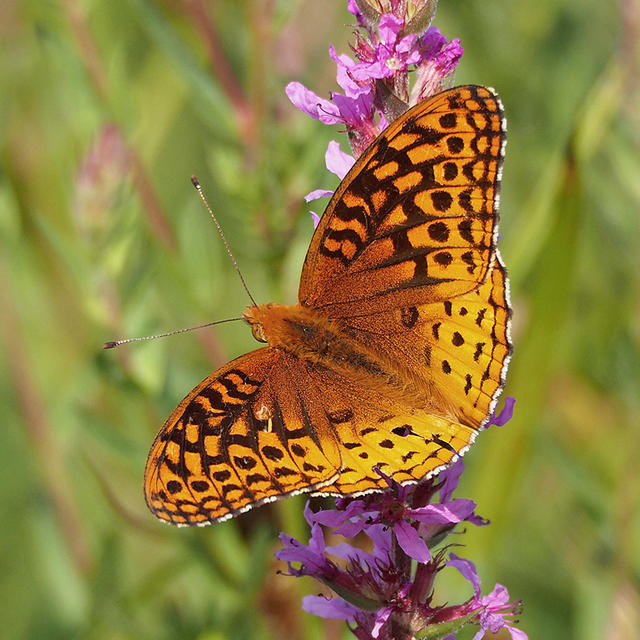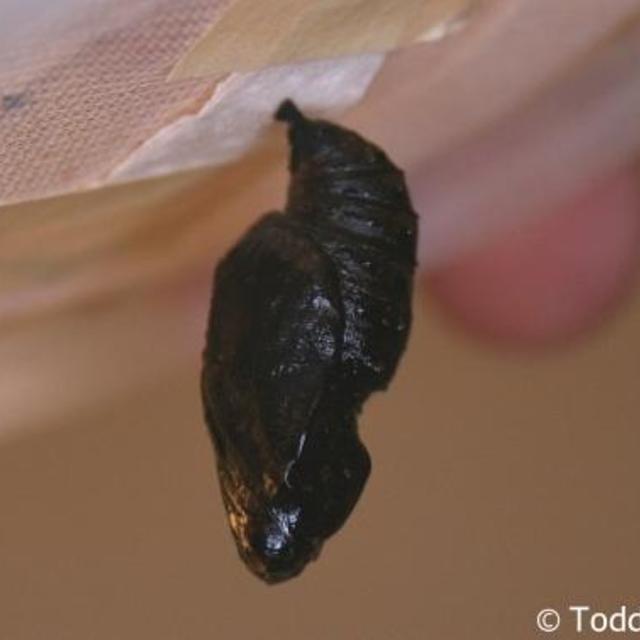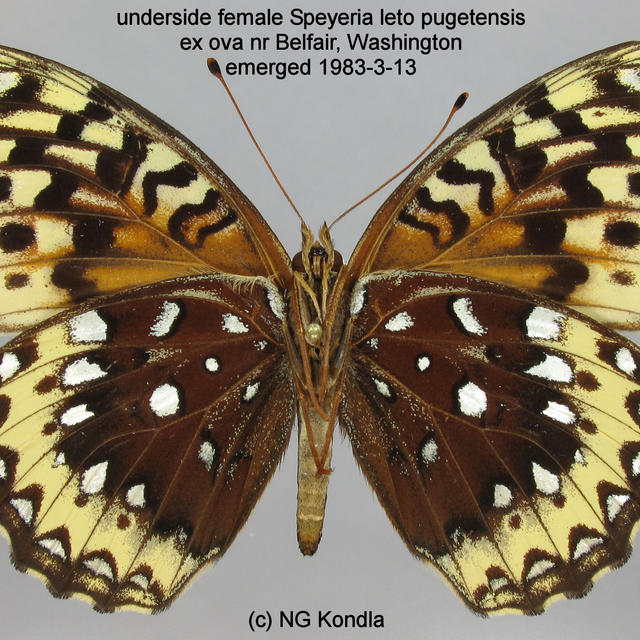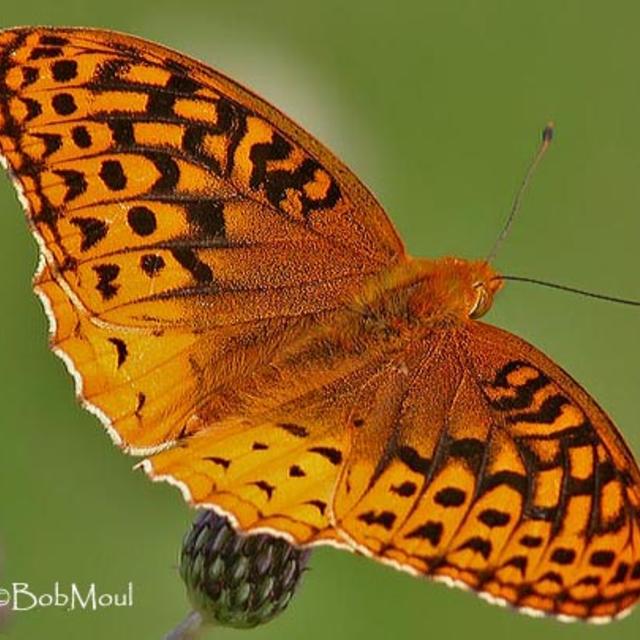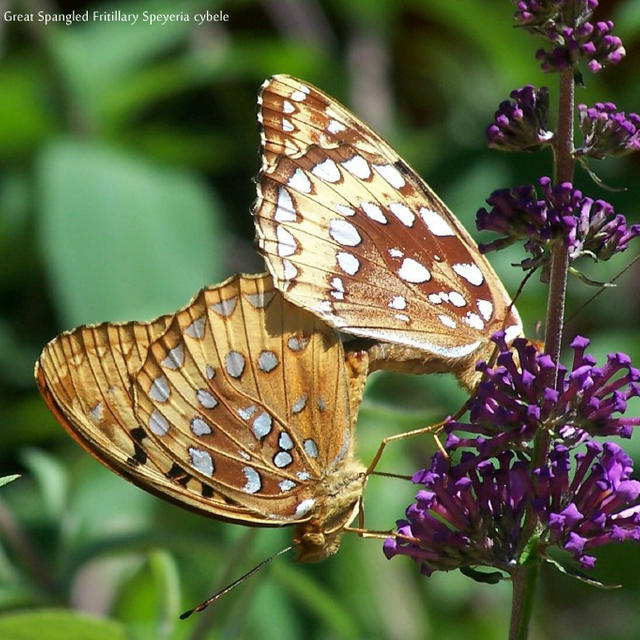Great Spangled Fritillary
Speyeria cybele (Fabricius, 1775)
Family: Nymphalidae
Subfamily: Heliconiinae
Identification: Large. Upperside of male tan to orange with black scales on forewing veins; female tawny, darker than male. Underside of hindwing with wide pale submarginal band and large silver spots.
Wing Span: 2 1/2 - 4 inches (6.3 - 10.1 cm).
Life History: Males patrol open areas for females. Eggs are laid in late summer on or near host violets. Newly-hatched caterpillars do not feed, but overwinter until spring, when they eat young violet leaves.
Flight: One brood from mid-June to mid-September.
Caterpillar Hosts: Various violet species (Viola).
Adult Food: Nectar from many species of flowers including milkweeds, thistles, ironweed, dogbane, mountain laurel, verbena, vetch, bergamot, red clover, joe-pye weed, and purple coneflower.
Habitat: Open, moist places including fields, valleys, pastures, right-of-ways, meadows, open woodland, prairies.
Range: Alberta east to Nova Scotia, south to central California, New Mexico, central Arkansas, and northern Georgia. Comments: The most common fritillary throughout most of the eastern United States.
Conservation: Not usually required.
NCGR: G5 - Demonstrably secure globally, though it may be quite rare in parts of its range, especially at the periphery.
Management Needs: None reported.
BAMONA Shop
Please donate!
We depend on donations to keep Butterflies and Moths of North America freely available. We want to express our gratitude to all who showed their support by making a contribution this year. You can donate to support this project at any time.
Advertise with us!
Do you have a product or service that you think would interest BAMONA users? If you would like to advertise on this website, contact us by email, or use the contact form and select the "Advertising" category.
Verified Sightings
Displaying 25 - 48 of 8171 verified sightings

Observation date: Jul 26, 2024
Submitted by: Tom Dudones
Region: Franklin County, New York, United States
Verified by: jmgesell
Verified date: Sep 01, 2024

Observation date: Aug 27, 2024
Submitted by: Kentonky41015
Region: Kenton County, Kentucky, United States
Verified by: CA Ivy
Verified date: Aug 29, 2024

Observation date: Aug 11, 2024
Submitted by: gypsynewtons
Region: Gilmer County, Georgia, United States
Verified by: Mikelchap
Verified date: Aug 28, 2024

Observation date: Aug 14, 2024
Submitted by: barthsm
Region: Franklin County, New York, United States
Verified by: jmgesell
Verified date: Aug 27, 2024

Observation date: Aug 27, 2024
Submitted by: Rbbrownbear
Region: Tolland County, Connecticut, United States
Verified by: jwileyrains
Verified date: Aug 27, 2024

Observation date: Aug 26, 2024
Submitted by: 865guy
Region: Anderson County, Tennessee, United States
Verified by: James Steen
Verified date: Aug 26, 2024

Observation date: May 18, 2024
Submitted by: ButtahflyEtn37354
Region: Monroe County, Tennessee, United States
Verified by: James Steen
Verified date: Aug 22, 2024

Observation date: Aug 18, 2024
Submitted by: ydlrun
Region: Dauphin County, Pennsylvania, United States
Verified by: davidwright
Verified date: Aug 21, 2024

Observation date: Aug 12, 2024
Submitted by: hrr705
Region: Tulsa County, Oklahoma, United States
Verified by: CA Ivy
Verified date: Aug 19, 2024

Observation date: Aug 11, 2024
Submitted by: maryjanzen
Region: Huntingdon County, Pennsylvania, United States
Verified by: davidwright
Verified date: Aug 19, 2024

Observation date: Aug 13, 2024
Submitted by: ian pepper
Region: Essex County, Massachusetts, United States
Verified by: jwileyrains
Verified date: Aug 15, 2024

Observation date: Jul 26, 2024
Submitted by: ian pepper
Region: Essex County, Massachusetts, United States
Verified by: jwileyrains
Verified date: Aug 15, 2024

Observation date: Jul 25, 2022
Submitted by: Keith Myrom
Region: Rice County, Minnesota, United States
Verified by: jmgesell
Verified date: Aug 13, 2024

Observation date: Aug 08, 2024
Submitted by: weflybye
Region: Mason County, Washington, United States
Verified by: davidwdroppers
Verified date: Aug 10, 2024

Observation date: Aug 07, 2024
Submitted by: Buddy Mays
Region: Jefferson County, Oregon, United States
Verified by: Ken Davenport
Verified date: Aug 09, 2024

Observation date: Aug 06, 2024
Submitted by: ButterBelle
Region: Putnam County, Tennessee, United States
Verified by: James Steen
Verified date: Aug 06, 2024

Observation date: Jul 31, 2024
Submitted by: J Tinsman
Region: Preston County, West Virginia, United States
Verified by: curtis.lehman
Verified date: Aug 05, 2024

Observation date: Aug 01, 2024
Submitted by: Jduval99
Region: Washington County, Pennsylvania, United States
Verified by: davidwright
Verified date: Aug 03, 2024

Observation date: Jul 26, 2024
Submitted by: barthsm
Region: Erie County, New York, United States
Verified by: jmgesell
Verified date: Aug 02, 2024

Observation date: Jul 27, 2024
Submitted by: plex1ppus
Region: Kootenai County, Idaho, United States
Verified by: stevekohler
Verified date: Jul 31, 2024

Observation date: Jul 18, 2024
Submitted by: MinPinLord
Region: Alberta, Canada
Verified by: J_Martineau
Verified date: Jul 29, 2024

Observation date: Jul 27, 2024
Submitted by: cp2023
Region: Fairfield County, Connecticut, United States
Verified by: jwileyrains
Verified date: Jul 28, 2024

Observation date: Jul 26, 2024
Submitted by: jwileyrains
Region: Litchfield County, Connecticut, United States
Verified by: jwileyrains
Verified date: Jul 26, 2024

Observation date: Jul 22, 2024
Submitted by: chirpingbirds
Region: Morgan County, Tennessee, United States
Verified by: James Steen
Verified date: Jul 25, 2024
- ‹ previous
- 2 of 341
- next ›





